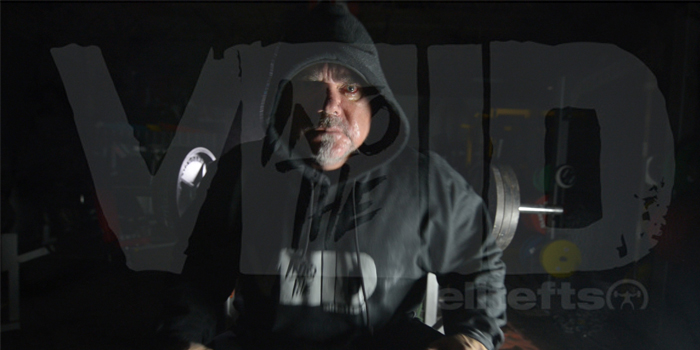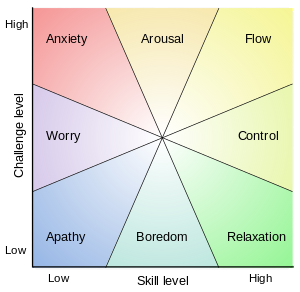
You've heard it before: sports announcers often talk about how well a team flows during gameplay or athletes in post-game interviews speak about how the game flowed for them that night. This use of the term "flow" is not by coincidence. Athletes, commentators, and sports fan aren't just using a buzzword to describe high-level sports — they're actually talking about an extensively studied psychological phenomenon.
In my last article, Music as a Performance Enhancer, I talked briefly about how music can positively or negatively affect an athlete's ability to attain flow states and how much influence a flow state could have on an athlete's ability. However, understanding just what the hell "flow" is seems to be half the battle. As a state of mind, it isn't tangible nor is it measurable. Flow is actually barely even noticeable by the person experiencing it. So how do we define it?
Photo credit: Csikszentmihalyi, M. (1997). Finding flow: The psychology of engagement with everyday life.
Mihaly Csikszentmihalyi, the creator of the psychological concept of flow, is one the of the greatest psychological minds of the last century. Mihaly essentially characterizes flow as a feeling of "great absorption, engagement, fulfillment, and skill—and during which temporal concerns (time, food, ego-self, etc.) are typically ignored." (Csikszentmihalyi, 1990)
I wonder where we've heard that before...
Maybe Dave was onto something with this "Void" thing after all.
The problem, however, is that many people try too hard to "enter the void" and leave an unacceptable amount of weight on the platform. Too much focus is put on having an elaborate set up with fancy jazz-hands and foot stomping. By the time you're ready to rip your third deadlift attempt off the floor, you've fallen off the peak of the arousal curve.
Even worse is when you've huffed and puffed and stomped your feet into position and unracked a squat, only to get stapled in the hole because you forfeited flow for flair. I've seen this cycle repeat for many lifters: amp up, exit peak arousal, and fail. I've watched too many lifters who were once overjoyed to compete bomb out and fall away from the sport because they simply tried too hard to have fun.
Do you think eight-time Mr. Olympia Ronnie Coleman whooped and booed for fun? Well, yes, some of it was probably for fun. But it was mostly done because his release of energy was a simple cue that helped him exist in a state of flow. In that same regard, Dave's ammonia inhaling episodes supersetted with incoherent grunts accomplishes the exact same goal — focusing and finding a preferred form of happiness. Combined with mental imagery and preferred music, these factors all play into proper flow attainment (Pates, 2003).
This brings us to another point: many people have commented on Dave's frequent use of ammonia. The fact is, yes, ammonia can be awesome and it can also be grossly misused, especially in training. If you're snorting just to snort and hope that you're suddenly psyched, you're just putting extra strain on your CNS and leading to possible overtraining. On the other hand, if used appropriately and under control, use of ammonia in training can bring an athlete into a flow state without straining the CNS to the point of being unrecoverable. This does require some trial and error and is not something you can expect to master overnight. Dave has mastered his arousal curve with over 30 years of under-the-bar experience, and it's a little different when he's taking well-practiced whiffs before speed work as opposed to newbies inducing nosebleeds.
RELATED: Breath Control for Optimal Performance
The point to remember is this: Take the time to learn your body and get a handle on your own arousal curve. Eliminate the hokey-pokey song and dance from your setup routine and simplify your setup to optimize your ability to attain flow. Find what works, keep it simple, and stick with it. The less you actively think about, the more likely you'll hit the flow state when you unrack the bar. Flow almost always goes hand-in-hand with the absence of critical thinking. Every training session should be viewed as an opportunity to program your autopilot.
Remember: To achieve a flow state, a balance must be struck between the challenge of the task and the skill of the performer. If the task is too easy or too difficult, flow cannot occur.
Second and third attempts are a battle between the existence of flow and the level of challenge that attempt provides. If your training has been adequate and your attempt selection smart, more likely than not, you're strong enough to make that lift. It's all about maintaining your flow state to bring everything together.
References
- Bishop, D. T., Karageorghis, C. I., & Loizou, G. (2007). A grounded theory of young tennis players’ use of music to manipulate emotional state. Journal of Sport & Exercise Psychology, 29, 584–607
- Csikszentmihalyi, M. (1990). Flow: The Psychology of Optimal Experience. New York: Harper and Row. ISBN 0-06-092043-2
- http://www.globoforce.com/gfblog/2013/happiness-flow-and-how-to-be-a-better-leader/
- Pates, J., Karageorghis, C. I., Fryer, R., & Maynard, I. (2003). Effects of asynchronous music on flow states and shooting performance among netball players. Psychology of Sport and Exercise, 4, 413–427.










